Expert Guide to Bathroom Floor Repair Around Toilet


Intro
Bathroom floor repair around the toilet is a topic that resonates with many homeowners and those managing rental properties. It's not merely a matter of aesthetics; it often directly impacts health and safety. Water damage, which can lead to mold, not only degrades the floor but also poses serious health risks. So, understanding how to manage these repairs is crucial for anyone wanting to keep their space functional and appealing.
In this comprehensive guide, we will dive into the myriad issues that can arise with bathroom flooring, particularly around the toilet area. We'll discuss not only the tools and materials you will need but also explore effective methods for restoring various types of flooring. Whether you are a DIY enthusiast or someone considering hiring professionals, the insights shared here will empower you to make informed decisions, ultimately enhancing both the utility and appearance of your bathroom.
Current Trends
When it comes to bathroom floor repair, staying up-to-date with current trends is essential. Homeowners today are looking for styles that combine functionality with aesthetic appeal.
Color Palettes
Recent trends showcase a variety of color palettes that echo cleanliness and calm. Popular choices range from soft pastels to earthy neutrals. For instance:
- Soft blues and greens evoke a spa-like atmosphere.
- Beige and cream create a timeless appeal.
Using these hues in floor designs helps in creating a bright, welcoming environment. Consider, for example, pairing a light gray vinyl flooring with bold, rich blue walls. The contrast is striking but doesn’t overwhelm the senses.
Popular Styles
In terms of flooring styles, several options have gained traction in recent years. Homeowners are often drawn to:
- Water-resistant laminates for their durability and low maintenance.
- Ceramic tiles, which offer a variety of patterns, making them ideal for personal expression.
- Luxury vinyl planks that mimic natural wood or stone while resisting moisture effectively.
Choosing the right style reflects your individual taste, and ensures the floor will withstand the wear and tear associated with bathroom use.
"The right flooring can elevate a bathroom into an inviting retreat, balancing beauty and practicality."
In today's market, it's equally important to consider sustainability. Many homeowners are trending towards eco-friendly materials or those sourced with minimal environmental impact. For example, bamboo and cork are both renewable options that add warmth to spaces.
Visual Ideas
Incorporating visuals can significantly enhance the decision-making process when repairing or updating your bathroom floor around the toilet area. Images showcasing successful bathroom styles can provide inspiration and a sense of direction.
Gallery of Styled Bathrooms
Take a moment to look at galleries available on platforms like Pinterest or home improvement websites. Here, you’ll find a treasure trove of styled bathrooms where repairs have been made with flair.
Before-and-After Transformations
Before-and-after images serve as powerful motivators. Witnessing how a new floor can be game-changing fosters hope that a DIY project can result in standout success. These transformations illustrate how skillfully executed repairs not only rejuvenate a space but also create an inviting atmosphere.
Aim to research these visual resources and perhaps bookmark your favorites for reference as you embark on your bathroom floor repair journey.
By understanding modern trends and visual inspirations, you will have the creative tools at your fingertips needed to embark on your bathroom floor repair project, turning a mundane task into a rewarding experience.
Understanding Bathroom Floor Issues
Bathroom floor issues can often seem like minor inconveniences, but they can escalate into significant problems if left unattended. In a space as frequently used as the bathroom, the condition of the flooring directly affects both functionality and overall aesthetics. Ensuring the floor remains in good shape means not only comfort underfoot but also preventing larger complications such as mold growth or structural damage. A well-maintained floor can enhance the space, making it more inviting and even affect the value of the property. It’s prudent to understand the common issues and causes to keep your bathroom safe and visually pleasing.
Common Problems Encountered
Water damage
Water damage is a pressing concern in bathrooms due to the constant exposure to moisture. Whether it's from overflowing sinks, a leaky toilet, or even condensation build-up, this type of damage can lead to warped boards and mold issues. It can manifest in several ways: dark stains, peaking tiles, or soft spots in the flooring. These are signs that water has compromised the integrity of your flooring. Addressing water damage not only restores appearance but also prevents more serious problems down the line, like structural degradation and health risks associated with mold and mildew. Ignoring these signs could mean big headaches in the future, not to mention a hefty repair bill.
Uneven flooring
Having uneven flooring can be more than just an eyesore—it poses a safety risk to anyone moving through the space. This can stem from various factors, such as settling of your home or moisture damage over time. An uneven surface can cause wobbling when standing or even lead to slips. While it may seem like a cosmetic issue, it’s worth addressing promptly to prevent further complications. Solutions exist, ranging from leveling compounds to complete floor resets, depending on the severity of the problem.
Stains and discoloration
Stains and discoloration can stem from many culprits, such as spills, cleaning products, or just the wear and tear typical in high-traffic areas. These unsightly marks not only tarnish the appearance of your bathroom but can also be indicative of deeper issues. Persistent stains might suggest underlying water damage or mold problems, which can compromise the floor’s structure. Keeping stains at bay involves employing the right cleaning techniques and regular maintenance, ensuring that the floor not only looks good but stays healthy underfoot.
Loose tiles or planks
Loose tiles or planks can create a disconcerting sensation when walking, and it's a clear signal that something’s amiss. This may stem from improper installation, shifting underfoot, or perhaps even moisture intrusion. If left unattended, loose tiles can eventually crack or break, leading to costly repairs. The unique aspect of this issue is that fixing it can often be straightforward, involving reapplying adhesive and ensuring proper grouting. However, neglecting it can significantly escalate the problem, so it's in your best interest to tackle it head-on.
Causes of Damage
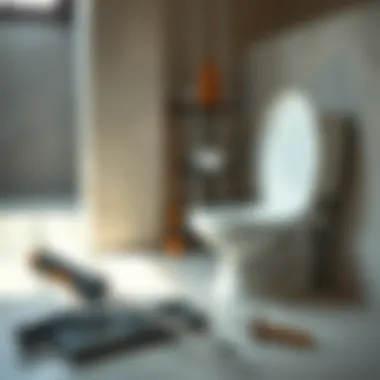
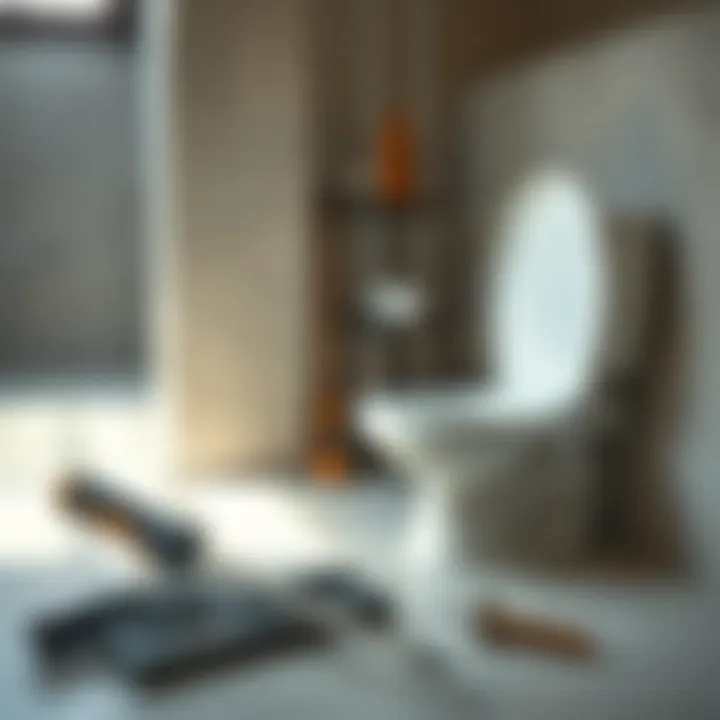
Leakage from the toilet
A leaking toilet is often the unseen culprit behind many flooring mishaps. Even a small drip can contribute to substantial water damage over time, leading to sagging and structural concerns. It’s essential to regularly inspect your toilet and its connections because a minor leak can become a major issue before you know it. Proactively addressing any signs of leakage is key to maintaining not only your bathroom floor but also your entire home’s health.
Condensation
Condensation occurs when humid air meets cooler surfaces, creating moisture buildup that often lands on bathroom floors. Over time, this moisture can lead to mold and mildew, not to mention aging out your flooring materials faster than expected. It's a silent issue, often overlooked, but can have lasting effects on both aesthetic and structural integrity. To combat condensation, one may consider improving ventilation, which makes a world of difference.
Poor installation
If flooring wasn’t properly laid down, it could lead to numerous headaches. Issues may not be apparent immediately but will rear their ugly heads as time passes. Uneven seams, failing adhesive, or misaligned pieces could all be results of subpar installation. Recognizing a poorly installed floor is critical; identifying and correcting these mistakes can save a lot of grief in the long run and ensure that your bathroom maintains both form and function.
Age of flooring materials
Lastly, the natural aging of flooring materials can’t be ignored. As time rolls on, everything from vinyl to tiles can lose their durability and charm, showing signs of wear and tear. This can manifest as chipping, cracking, or general dullness that even the best cleaning products can't combat. While replacement isn’t always necessary, it is important to evaluate when a fix is more cost-effective than a replacement. Woods, for example, may warp over time, losing their integrity and requiring immediate attention.
Regular assessments can help nip potential problems in the bud before they escalate into larger, more expensive repairs.
Understanding these issues and their causes can empower homeowners and DIY enthusiasts alike to take steps before a small problem becomes a big headache.
Preparation for Repairs
Preparing for repairs in the bathroom, especially around the toilet, is crucial. It sets the tone for the entire project. Having a clear plan can save you time, effort, and even money. Before you dive headfirst into the repair, it is vital to gather the right tools and materials, assess the extent of the damage, and ensure that you understand what you are up against. By taking these preliminary steps, you create a smoother workflow, reduce frustrations, and can more effectively tackle the challenges that arise.
Gathering Tools and Materials
Basic tools for flooring repair
When it comes to basic tools for flooring repair, there are a handful you won't want to skimp on. A good quality pry bar helps in removing old flooring without causing unnecessary damage. Additionally, a utility knife is essential for cutting new materials precisely. A measuring tape will ensure that your dimensions are spot on, which is pivotal for a successful installation.
These tools are popular because they don't complicate the process. They're straightforward and effective, allowing even amateurs to step into the role of DIY enthusiast without feeling overwhelmed. The unique feature of these basic tools is their versatility; they can be utilized in different aspects of home repair beyond just flooring, making them a worthwhile investment.
Choosing the right adhesive
Choosing the right adhesive is a key aspect that can make or break your flooring project. The adhesive must be strong enough to withstand water exposure and foot traffic. Different adhesives possess various drying times and bonding strengths, so it's wise to familiarize yourself with the offerings available.
A popular choice in this realm is a high-quality waterproof adhesive. The unique advantage of using this type is that it remains effective even in a moist environment, ensuring longevity. Yet, it's important to consider the potential downside: some adhesives have strong odors during the curing process, which can be a drawback for those sensitive to smells.
Selecting replacement flooring
Selecting the right replacement flooring is another critical piece of the puzzle when repairing your bathroom floor around the toilet. The materials used must be waterproof or resistant, durable enough to handle high foot traffic, and in style with the overall bathroom aesthetic. There’s a wide array of options including vinyl, tiles, and laminate.
Vinyl flooring, for instance, has gained traction due to its resilience and affordability. Its unique feature is that it's often available in a wide range of designs and styles, making it easy to match with existing décor. However, one aspect to watch out for is the quality of the product; cheaper vinyl may not hold up over time compared to higher-end selections.
Assessing the Damage
Before diving into the actual repair work, it's necessary to assess the damage effectively. Identifying the extent of the damage, checking for mold or moisture, and testing the stability of your flooring will make all the difference in your undertaking. Ignoring these steps might lead to poor repairs or even more extensive issues down the line.
Identifying extent of damage
Identifying the extent of damage is essential for determining what repairs need to be made. Sometimes, a simple water stain may hide more significant problems beneath the surface, such as structural compromises.
The key characteristic in assessing damage accurately lies in the thoroughness of your inspection. Being diligent can often reveal whether the problem is minor or requires major intervention, directing your next steps appropriately. However, spending too much time over-analyzing may lead to hesitation in decision-making, causing unnecessary delays.
Checking for mold or moisture
Checking for mold or moisture should not be taken lightly; both can lead to severe health risks if left unaddressed. Inspecting around the toilet and in corners is important, as these areas might retain moisture more than others.
The key feature of this inspection is that it protects not only your flooring but also your health. The presence of mold might mean that repairs need to be more than cosmetic. While catching these issues early on is advantageous, one must also balance thorough inspections to avoid slowing down the repair process unnecessarily.
Testing flooring stability
Testing flooring stability is the final piece before getting into the repairs. You want to ensure that the subfloor can handle the load of people using the toilet – after all, stability is key to a long-lasting fix. Simply walking around the area to check for movement can provide insight into the condition of the floor.
The unique characteristic of this step is that it gives a clear indication of whether further work is necessary. If the flooring feels soft or bouncy, it may require further intervention before new flooring can be laid down. Though crucial, overanalyzing during this step doesn’t bring benefit. Just a quick assessment and you're on your way!
Repairing Water-Damaged Floors
Repairing water-damaged floors is a critical component of bathroom maintenance. If the flooring around your toilet has seen better days, acting swift can save you from larger issues down the line. Water damage can lead to mold, unpleasant odors, and structural instability. Such consequences make this not just an aesthetic concern but a health and safety one too.
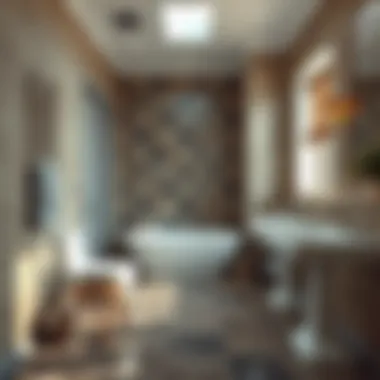
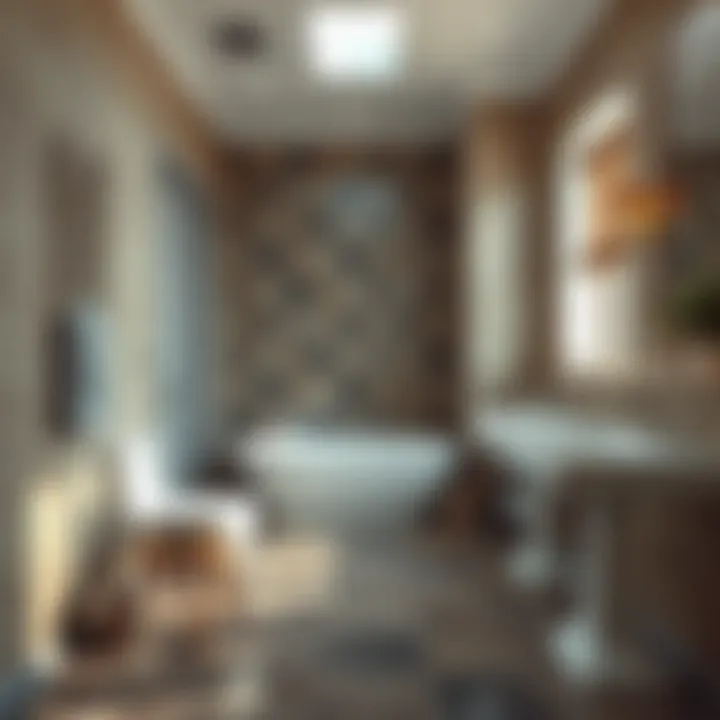
By addressing water damage promptly, you protect your home and family from potential hazards. It’s also an opportunity to refresh the look of your bathroom, making it more pleasant and functional. Let’s delve deeper into the steps involved in repairing those water-damaged areas of your floor, beginning with how to remove the existing flooring that is no longer serving you well.
Removing Damaged Flooring
Tools required for removal
When it comes to ripping out the damaged flooring, having the right tools can make all the difference. Tools like a pry bar, utility knife, and a hammer are essential. A pry bar allows you to lift planks or tiles without causing major damage to the surrounding materials.
Another key player in this toolkit is the utility knife. It's precise, quick, and reliable when cutting through vinyl or other materials. The beauty of these tools lies in their availability and affordability.
These basic tools provide strong utility, making them popular among DIYers, especially since they are easy to manage for most homeowners without specialized training.
Steps for safe removal
Removing flooring isn’t just about strength; it’s also about technique. Start by ensuring the bathroom is well-ventilated—open windows or turn on exhaust fans. From there, it’s important to score the flooring carefully, especially if you're dealing with tiles; use the utility knife to break any adhesive bonds first.
Gently leverage the pry bar underneath to lift tiles or planks up. Keep an eye out for nails or screws, and remove those as they come. By following these steps, you minimize risk and avoid additional damage which can save you hassle later on. Doing this safely guarantees that the subfloor below remains intact, reducing the amount of extra work that might be needed.
Disposing of damaged materials
Disposing of old flooring materials is as crucial as the removal process. Simply throwing it all in the trash isn't environmentally sound. Many flooring materials can be recycled or disposed of properly by taking them to local waste management facilities.
Engaging in responsible disposal not only reduces landfill waste but may also save you a few bucks on potential fees from improper disposal. Some places even have specific drop-off sites for materials like vinyl or tile.
Taking the time to understand local disposal regulations is often overlooked during this process. Not only does it contribute positively to the environment, but it also ensures your home stay compliant with local laws, giving you peace of mind while working on repairs.
Assessing Subfloor Condition
Checking for rot or softness
Once the damaged flooring has been removed, your focus shifts to the subfloor condition. Checking for rot or softness is paramount; a sturdy subfloor is the foundation of a durable flooring system.
Use simple methods like pressing down with your foot to check for softness in different areas. A soft spot usually indicates trouble—possibly moisture damage or rot. When you find this, it signals the need for immediate action to preserve the integrity of the entire floor. Ignoring rot can lead to larger problems, down the line which might cause structural failure.
Replacing sections of subfloor if necessary
If your inspection reveals that sections of the subfloor are indeed weak or rotting, replacement becomes essential. This step often feels daunting, but it’s crucial for longevity in your flooring investment. First, cut out the damaged sections carefully with a saw. Try to leave some of the sound subfloor edges intact to join subsequently with the new wood.
Choosing the correct type of plywood or OSB is key here. For many homeowners, it often means making a trip to the local hardware store, which can also be a chance to get good advice from knowledgeable staff about what materials might work best. This added effort can ensure your subfloor is as solid as a rock for the new flooring.
Moisture barrier installation
After replacing any damaged sections of the subfloor, incorporating a moisture barrier is wise. This layer protects against future water infiltration and adds longevity to your new flooring. Common options include polyethylene sheeting or specialized flooring underlayment designed for moisture control.
The installation process is simple—lay the moisture barrier over the subfloor before putting your new flooring down. This step often goes unnoticed but is essential for mitigating future problems arising from humidity and spills. Failure to install this barrier can lead to all your hard work being undone by moisture over time, creating bigger issues despite your immediate repairs.
Installing New Flooring
Types of flooring options
Now comes the fun part—choosing your new flooring. There are several options available, each with different properties and aesthetics. Vinyl flooring often pops up on the radar due to its water resistance, affordability, and ease of installation. On the other hand, ceramic tiles provide durability and a touch of elegance, albeit with a higher cost.
You may also consider luxury vinyl plank, which mimics the appearance of wood but offers enhanced resistance to moisture. Each type has advantages and disadvantages, thus weighing these factors before making a decision is important. Let's keep practicality and style at the forefront of the selection process.
Installation techniques
When it comes to laying down new flooring, using the right installation technique is key. Most vinyl floors utilize a peel-and-stick method, making it user-friendly for DIYers aiming to save on labor costs. If you’re going with tiles, thin-set mortar is paramount for a secure bond.
Having an understanding of these installation techniques equips you for a successful outcome. Watch tutorials or speak with knowledgeable staff at your local home improvement store for added tips.
Ensuring proper alignment and fitting
The final step is ensuring that your new flooring aligns and fits nicely. Misalignment can lead to uneven surfaces, which is not only unattractive but could lead to tripping hazards. Take your time during this phase—measure twice, cut once is the mantra that pays off in precision.
Most types of flooring have clear guidelines regarding installation, making it easier for you to achieve a perfect fit. By double-checking your work, you're setting the stage for durable, long-lasting floors that not only look good but feel good underfoot.
Addressing Other Flooring Issues
When it comes to maintaining the integrity of your bathroom, addressing other flooring issues is more crucial than one might think. Over time, your bathroom floor might face challenges beyond just water damage. Ensuring your floor is even and secure is as vital as fixing leaks or stains, as it contributes to safety and comfort. In this section, we will explore how to fix uneven floors and repair loose tiles, both of which are essential tasks to keep your bathroom in tip-top shape.
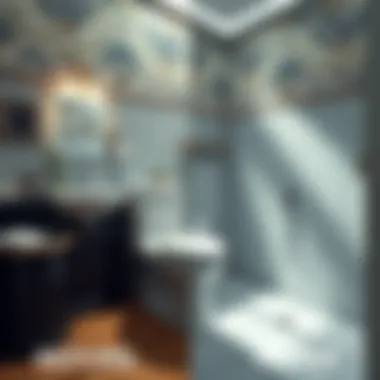
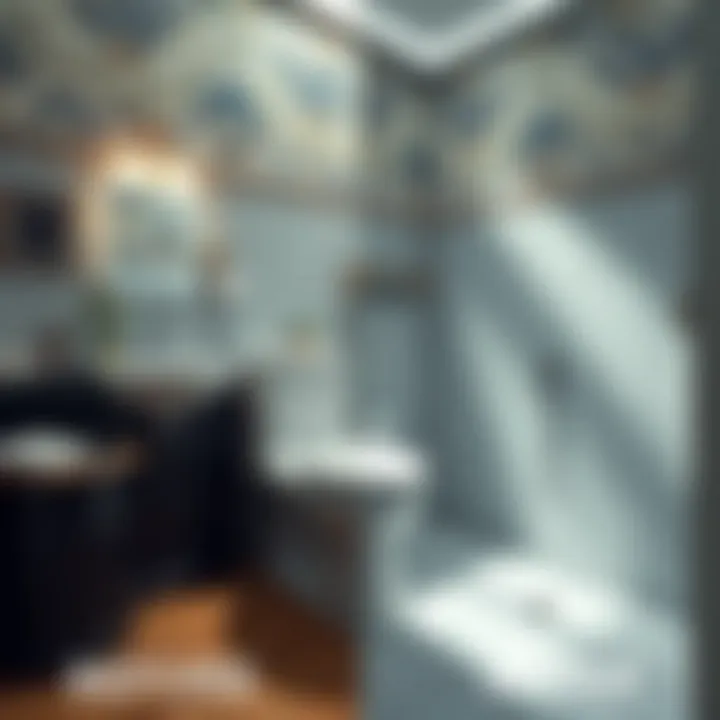
Fixing Uneven Floors
Uneven flooring can be a silent nuisance in your bathroom.
Identifying uneven spots
Identifying uneven spots is a foundational step towards achieving a level floor. This process involves walking around your bathroom, feeling for dips or raises underfoot. Often, a floor that seems level at first glance might hide some bumps or hollows beneath the surface. You can use a marble or a small ball in the bathroom to observe how it rolls; wherever it stops or changes direction can signal a problem area. Spotting these uneven areas early is a beneficial choice that can prevent more severe issues later on. Ignoring them may lead to complications with your tiles or not just just their aesthetic appeal, but functionality too, leading towards costly repairs down the road.
Using floor leveling compound
Using floor leveling compound is an effective remedy once you've pinpointed the trouble spots. This compound is latex-based and spreads quite easily over the existing surface. It’s quite handy for minor dips in areas, allowing for a smooth surface onto which tiles can adhere properly. One notable feature of floor leveling compound is its self-leveling characteristic; you pour it, and it spreads out evenly, filling in those dips nicely. It’s a popular choice since it saves substantial labor and yields a flat surface.
Rechecking after application
Rechecking after application ensures that you didn’t miss any spots or leave overly low areas. It’s like a second set of eyes to confirm that everything is as it should be. After the compound sets, checking with a level will validate your work. This step highlights its importance in the overall process, providing that assurance that your flooring is as even as it can get. Skipping this could lead to insufficient alignment issues during tile installation, potentially causing future problems.
Repairing Loose Tiles
Loose tiles can be both an eyesore and a safety hazard. Not only can they cause trips, but they also often let moisture creep under the surface, leading to bigger issues down the line.
Determining cause of looseness
Determining the cause of looseness is the first step towards a solid fix. Common culprits include improper installation, wear and tear over time, or even structural issues beneath the tile. It’s vital to inspect each loose tile thoroughly to find out why it’s become unfastened in the first place. This insight allows for more effective repair methods later. Identifying the cause can save you from further frustrations and help tailor your approach.
Applying adhesive correctly
Applying adhesive correctly is key to securing the tiles back in place. It’s important to use a strong adhesive, specifically made for bathroom floors, as moisture and changing temperatures can affect longevity. Spreading the adhesive evenly under each tile helps avoid future loosening and creates a strong bond. The right application technique is crucial; if not done well, even the best adhesive won’t hold up. It’s a fundamental choice that can lead to long-lasting results if executed with care.
Grouting and sealing tiles
Grouting and sealing tiles is the finishing touch that protects your work. Once the tiles are secured, applying grout helps fill in the gaps, creating a uniform appearance. Sealing the grout also prevents water from seeping in, which helps keep moisture at bay. The exciting part about this step is the peace of mind it provides, knowing that your repairs are now safeguarded against future water intrusion. Yet, it’s essential to wait for the grout to cure properly, as jumping the gun could lead to cracks when the surface settles.
In summary, addressing uneven floors and repairing loose tiles ensures a safer and more appealing bathroom environment. Ignoring these issues could turn a minor inconvenience into a major headache down the line.
Preventive Measures
Preventing future damage to your bathroom floor, especially around the toilet, is not just a good idea—it's a necessity. The wet and humid environment in bathrooms makes them prone to various issues. By implementing preventive measures, you can save yourself a bundle on future repairs and maintain the integrity of your flooring. Simple practices can make a world of difference.
Regular Maintenance Practices
Periodic inspections
Conducting regular inspections is one of the best ways to keep your bathroom floor in good shape. By taking the time to check your flooring routinely, you can catch potential issues before they escalate. Look for signs of wear or moisture; sometimes even small cracks can lead to bigger problems down the line. This practice is beneficial because it allows you to stay on top of any developing issues that could otherwise go unnoticed. The unique feature of periodic inspections is their proactivity; they empower homeowners to take charge of their spaces. However, this approach requires a bit of discipline to ensure that the checks are carried out consistently.
Cleaning techniques to avoid damage
Proper cleaning methods can significantly impact the lifespan of your bathroom floor. Using the right cleaning products is crucial; harsh chemicals can weaken adhesives and degrade flooring materials. Opt for gentle cleaners that don’t leave residue. Regular maintenance also extends to sweeping and mopping to remove debris and moisture, preventing stains and mildew. A unique feature here is that a little effort goes a long way, as consistent cleaning can help avoid major repairs. However, finding the balance between thorough cleaning and using safe products may need some trial and error.
Identifying early signs of trouble
Being vigilant about spotting early signs of trouble is another form of preventive measure. This could be anything from small water stains to a sticky feeling on your floor. When such signs are caught early, they can often be remedied with minimal intervention. The advantage lies in the knowledge that you are safeguarding your investment and can avoid costly repairs. This practice, though simple, relies heavily on being observant and aware of changes in your bathroom’s condition, which makes it essential for homeowners.
Improving Bathroom Ventilation
Benefits of proper airflow
Good ventilation is pivotal in maintaining the bathroom floor's integrity. Proper airflow helps in reducing moisture buildup, which can cause warping and mold. By preventing humidity from hanging around, you protect both the floor and the overall atmosphere of the bathroom. The unique characteristic of a well-ventilated bathroom is that it can also create a fresher space to enjoy. However, it can involve some initial setup, like installing or upgrading exhaust fans.
Ventilation options for bathrooms
When it comes to ventilation, there are various options homeowners can explore. From traditional exhaust fans to windows that can be opened, each has its place in effective moisture control. Installing a fan that vents outside is generally considered the most effective route to take. This option is particularly beneficial as it actively removes moisture instead of just recirculating it. Nevertheless, it can require some DIY skills or professional help, which may deter some people.
Using dehumidifiers effectively
Dehumidifiers can be a game-changer in keeping bathroom humidity levels low. When strategically placed, they suck unwanted moisture out of the air, thus minimizing condensation on surfaces. This method is beneficial for maintaining a dry environment, especially in bathrooms that lack windows. A unique feature here is the ability to control humidity at a set level. On the flip side, dehumidifiers consume electricity, and some models can be quite noisy, which might not sit well with all homeowners.
Closure
After diving into the intricacies of repairing bathroom flooring around the toilet, it’s clear just how crucial this process is. Not only does it ensure the safety and functionality of your bathroom, but it also contributes significantly to the overall aesthetic of the space.
Understanding the steps involved in addressing water damage, uneven floors, and loose tiles equips homeowners with the knowledge needed for effective repairs.
Recap of Key Steps
When tackling bathroom floor repairs, there are several steps one should keep in mind:
- Identify the Damage: Pinpointing the exact issue is fundamental. Whether it's water damage or tile looseness, this knowledge guides all subsequent actions.
- Gather Tools and Materials: Equip yourself with the necessary tools like a pry bar for tile removal, appropriate adhesive, and replacement flooring. Preparing well will streamline the repair.
- Remove Damaged Areas: If your flooring is beyond saving, it’s imperative to remove affected sections carefully, ensuring minimal disruption to the surrounding areas.
- Assess and Repair the Subfloor: Before installing new flooring, check the subfloor’s condition. If it’s rotting or unstable, replacing it can avoid further issues down the line.
- Install New Flooring: Choose suitable flooring that fits your bathroom’s style and is water-resistant. Measure accurately and align meticulously for a polished look.
- Implement Preventive Measures: Regular upkeep and proper ventilation can stave off future problems before they arise.
"A stitch in time saves nine." Addressing these repairs promptly can save you from bigger headaches in the future.
Encouragement for DIYers
For those eager to take matters into their own hands, remember that tackling these repairs not only saves on professional labor costs but also allows for a personal touch in your bathroom. Embrace the learning curve. Each tool you use and each tiling technique you master can boost your confidence. Yes, there might be a few missteps along the way, but there’s a profound satisfaction in completing a project yourself. Whether it’s your first undertaking or you’re using seasoned skills, the key is to stay patient and meticulous. There’s nothing quite like enjoying a beautifully renovated bathroom knowing you were the one who made it happen. For further guidance, you can explore practical resources such as Reddit or educational sites like Wikipedia for more tips.



